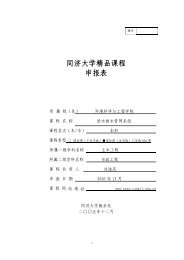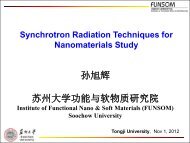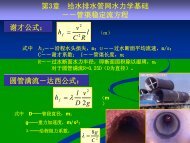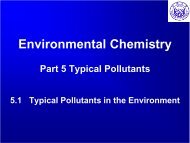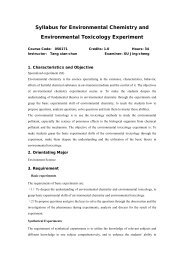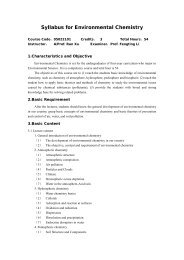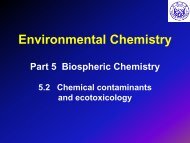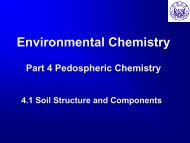Stratospheric Ozone Depletion
Stratospheric Ozone Depletion
Stratospheric Ozone Depletion
You also want an ePaper? Increase the reach of your titles
YUMPU automatically turns print PDFs into web optimized ePapers that Google loves.
Environmental Chemistry<br />
Part 2 Atmospheric Chemistry<br />
2.6 <strong>Stratospheric</strong> <strong>Ozone</strong> <strong>Depletion</strong>
<strong>Ozone</strong> in the atmosphere
The ozone layer
Ultraviolet protection by ozone<br />
<strong>Ozone</strong> absorbs UV light in the solar irradiation that is<br />
harmful to life
Ultraviolet protection by ozone<br />
The overlap of ground level radiation with the sunburn<br />
sensitivity curve would be much greater without the filtering<br />
effects of the ozone layer.
Express ozone abundance<br />
• Total column ozone is the total amount of ozone<br />
integrated from the surface to the top of the<br />
atmosphere.<br />
• Dobson Units (DU) is used to express the total column<br />
ozone, named after G.M.B. Dobson, a scientist who<br />
conducted pioneering measurements of the<br />
stratosphere in the 1920s and 1930s.<br />
• One DU is the thickness, measured in units of<br />
hundredths of a millimeter (0.01 mm), that the ozone<br />
column would occupy at standard temperature and<br />
pressure (273 K and 1 atm)
Typical ozone column values<br />
• Total ozone column value ranges from 290 to<br />
310 DU over the globe.<br />
• If all the atmosphere's ozone were brought<br />
down to the earth's surface at standard<br />
pressure and temperature, it would produce a<br />
layer of about 3mm thick.<br />
• <strong>Ozone</strong> depletion: when sum of ozone over<br />
height is lower than 2/3 of the normal value,<br />
we say "ozone depletion" occurs.
What is ozone?<br />
<strong>Ozone</strong> is a stable molecule<br />
composed of three oxygen atoms. O<br />
While stable, it is highly reactive. The Greek word ozein<br />
means “to smell” and O 3 has a strong pungent odor.<br />
Electric discharges in air often produce significant<br />
quantities of O 3 and you may have smelled O 3 near these<br />
sources.<br />
O<br />
O
<strong>Ozone</strong> formation and destruction in the<br />
stratosphere
Chapman Theory<br />
a) O 2 + hv ( 2O<br />
b) O+O 2 +M -> O 3 +M<br />
c) O 3 + hv (
Prediction by Chapman theory vs. Observation<br />
Using Chapman theory
There must be other O 3 destruction pathways<br />
Catalytic ozone destruction<br />
Net reaction<br />
X + O 3 = XO + O 2<br />
XO + O = X + O 2<br />
O + O 3 = 2 O 2<br />
X is a regenerated in the process – act as a catalyst.<br />
The chain reaction continues until X is removed by some<br />
side reaction.
The important catalysts for stratospheric<br />
O 3 destruction<br />
• Hydroxy radical (OH)<br />
. .<br />
OH + O3 = HO2 + O2<br />
HO 2<br />
. + O = . OH + O2<br />
Net: O + O 3 = 2O 2<br />
• Chlorine and bromine (Cl and Br)<br />
Cl . + O 3 = ClO . + O 2<br />
ClO . + O = Cl . + O 2<br />
Net: O + O 3 = 2O 2<br />
• Nitric oxide (NO)<br />
NO + O 3 = NO 2 + O 2<br />
NO 2 + O = NO + O 2<br />
Net: O + O 3 = 2 O 2<br />
HOx cycle<br />
ClOx cycle<br />
NOx cycle
Hydroxy radical<br />
• Accounts for nearly one-half of the total ozone<br />
destruction in the lower stratosphere (16-20 km).<br />
• Sources<br />
O3 + hv (
Chlorine atom<br />
Sources:<br />
Photolysis of Cl-containing compounds in the stratosphere.<br />
CFCl3 + hv (185-210nm) CFCl .<br />
2 + Cl .<br />
CF2 Cl2 + hv (185-210nm) CF2 Cl . + Cl .<br />
Subsequent reactions of CFCl2 and CF2 Cl more Cl atoms<br />
The principal Cl-containing species are:<br />
CF2 Cl2 , CFCl3 , CFCl2 , CF2 Cl, CCl4 , CH3 CCl3 , CF2 HCl, CH3 Cl<br />
Sources for Cl-containing compounds (need to be long-<br />
lived in the troposphere)<br />
•Man-made: e.g. CFCs<br />
•Natural: e.g. methyl chloride from biomass burning.
Chlorofluorocarbons (CFCs)<br />
• CFCs is the abbreviated form of ChloroFluoroCarbons, a<br />
collective name given to a series of compounds<br />
containing chlorine, fluorine and carbon atoms.<br />
Examples: CFCl 3 , CF 2 Cl 2 , and CF 2 ClCFCl 2 .<br />
• Related names<br />
– HCFCs: Hydrochloroflorocarbons, halocarbons<br />
containing hydrogen atoms in addition to chlorine,<br />
fluorine and carbon atoms.<br />
– HFCs: hydroflorocarbons, halocarbons containing<br />
atoms of hydrogen in addition to fluorine and carbon<br />
atoms.<br />
– Perhalocarbons: halocarbons in which every available<br />
carbon bond contains a haloatoms.<br />
– Halons: bromine-containing halocarbons, especially<br />
used as fire extinguishing agents.
Chlorine atom (Continued)<br />
Termination reactions for Cl<br />
Cl . + CH 4 <br />
ClO . + NO 2 + M<br />
Reservoir species<br />
CH 3 . + HCl<br />
Stable in the stratosphere<br />
Removed from air by precipitation<br />
when it migrates to the troposphere<br />
ClONO 2 + M<br />
Relatively unreactive but can regenerate<br />
reactive species upon suitable conditions<br />
ClONO 2 + hvClO + NO 2<br />
ClONO 2 + hvCl + NO 3
Nitric oxide<br />
• NO is produced abundantly in the troposphere,<br />
but all of it is converted into NO2 HNO3 (removed through precipitation)<br />
• NO in the stratosphere produced from nitrous<br />
oxide (N2 O), which is much less reactive than NO.<br />
N2 O + hv N2 + O (90%)<br />
N2 O + O 2 NO (~10%)<br />
• Removal processes:<br />
NO2 + . OH HNO3 ClO . + NO2 ClONO2 Inhibit the HOx<br />
and ClOx cycles
The two-sided effect of NOx<br />
• NOx provides a catalytic chain mechanism for<br />
O 3 destruction.<br />
• NOx inhibit the HOx and ClOx cycles for O 3<br />
destruction by removing radical species in the<br />
two cycles.<br />
• The relative magnitude of the two effects is<br />
altitude dependent.<br />
– >25 km, the net effect is to destruct O 3 .<br />
– (NOx accounts for >50% of total ozone destruction<br />
in the middle and upper troposphere.)<br />
– In the lower stratosphere, the net effect is to protect<br />
O 3 from destruction.
The catalytic destruction reactions described so far,<br />
together with the Chapman cycle, account for the<br />
observed average levels of stratospheric ozone, they<br />
are unable to account for the ozone hole over<br />
Antarctica.<br />
The ozone depletion in the Antarctica is limited both<br />
regionally and seasonally. The depletion is too great<br />
and too sudden. These observations can not be<br />
explained by catalytic O 3 destruction by ClOx alone.
Numbering system for CFCs and HCFCs<br />
CFC-XYZ<br />
1) Z = number of fluorine atoms.<br />
2) Y =1 + number of hydrogen atoms.<br />
3) X = number of carbon atoms -1<br />
When X=0 (i.e., only one carbon compound), it is omitted.<br />
4) The number of chlorine atoms in the compound is found by<br />
subtracting the sum of fluorine and hydrogen atoms from the<br />
total number of atoms that can be connected to the carbon<br />
atoms.<br />
5) Examples:<br />
CCl2F2 (CFC-12, refrigerant)<br />
CCl3F (CFC-11, blowing agent)<br />
CHClF2 (CFC-22, refrigerant, blowing agent)<br />
C2Cl2F4 (CFC-114)
The <strong>Ozone</strong> Hole
The discovery of the ozone hole<br />
• The British Antarctic Survey has been monitoring, for<br />
many years, the total column ozone levels at its base<br />
at Halley Bay in the Antarctica.<br />
• Monitoring data indicate that column ozone levels<br />
have been decreasing since 1977.<br />
• This observation was later confirmed by satellite data<br />
(TOMS-Total <strong>Ozone</strong> Mapping Spectrometer)<br />
– Initially satellite data were assumed to be wrong<br />
with values lower than 190DU
October ozone hole over Antarctic
Features of the ozone hole<br />
• <strong>Ozone</strong> depletion occurs at altitudes between 10<br />
and 20 km<br />
– If O3 depletion resulted from the ClOx cycle, the<br />
depletion would occur at middle and lower latitude<br />
and altitudes between 35 and 45 km.<br />
– The ClOx cycle requires O atom, but in the polar<br />
stratosphere, the low sun elevation results in<br />
essentially no photodissociation of O2 .<br />
– The above observation could not be explained by<br />
the ClOx destruction mechanism alone.<br />
• <strong>Depletion</strong> occurs in the Antarctic spring
Special Features of Polar Meteorology<br />
• During the winter polar night, sunlight does not reach the<br />
south pole.<br />
• A strong circumpolar wind develops in the middle to lower<br />
stratosphere; These strong winds are known as the 'polar<br />
vortex'.<br />
• In the winter and early spring, the polar vortex is<br />
extremely stable, sealing off air in the vortex from that<br />
outside.<br />
• The exceptional stability of the vortex in Antarctic is the<br />
result of the almost symmetric distribution of ocean<br />
around Antarctica.<br />
• The air within the polar vortex can get very cold.<br />
• Once the air temperature gets to below about -80C (193K),<br />
Polar <strong>Stratospheric</strong> Clouds (or PSCs for short) are formed.
Polar vortex<br />
• The polar vortex is a persistent large-scale<br />
cyclonic circulation pattern in the middle and<br />
upper troposphere and the stratosphere,<br />
centered generally in the polar regions of<br />
each hemisphere.<br />
• The polar vortex is not a surface pattern. It<br />
tends to be well expressed at upper levels of<br />
the atmosphere (> 5 km).
Polar <strong>Stratospheric</strong> Clouds (PSCs)<br />
• PSCs first form as nitric acid trihydrate (HNO 3 . 3H2 O)<br />
once temperature drops to 195K.<br />
• As the temperature gets colder, larger droplets of<br />
water-ice with nitric acid dissolved in them can form.<br />
• PSCs occur at heights of 15-20km.
Why do PSCs occur at heights of 15-20 km?<br />
• The long polar night produces temperature as<br />
low as 183 k (-90oC) at heights of 15 to 20<br />
km.<br />
• The stratosphere contains a natural aerosol<br />
layer at altitudes of 12 to 30 km.
PSCs promote the conversion of inorganic Cl<br />
and Cl reservoir species to active Cl<br />
Pathway 1 : HCl(g) Cl2 (g)<br />
• Absorption of gaseous HCl by PSCs occurs very<br />
efficiently<br />
HCl(g) HCl(s)<br />
• Heterogeneous reaction of gaseous ClONO2 with HCl<br />
on the PSC particles<br />
HCl(s) + ClONO2 HNO3 (s) + Cl2 where s denotes the PSC surface<br />
Note: The gas phase reaction between HCl and ClONO 2 is<br />
extremely slow.
PSCs promote the conversion of inorganic Cl<br />
and Cl reservoir species to active Cl<br />
(Continued)<br />
• Pathway 2: HCl(g)ClNO2 (g) in the presence of<br />
N2 O5 HCl(g) HCl(s)<br />
HCl(s) + N 2 O 5 <br />
ClNO 2 + HNO 3 (s)<br />
• Pathway 3: ClONO 2 (g)HOCl (g)<br />
ClONO 2 + H 2 O (s) <br />
HOCl + HNO 3 (s)<br />
The gas phase reactions between HCl and N 2 O 5 ,<br />
between ClONO 2 and H 2 O are too slow to be important.
Why PSCs promote the conversion of inorganic<br />
Cl and Cl reservoir species to active Cl?<br />
1. PSCs concentrate the reactant molecules.<br />
2. Formation of HNO3 is assisted by hydrogen bonding<br />
to the water molecules in the PSC particles.
Active Cl species can rapidly yield Cl<br />
atoms when light is available<br />
• Active Cl species include Cl2 , HOCl, and ClNO2 • Active Cl species readily photolyze to yield Cl atoms<br />
when daylight returns in the springtime.<br />
Cl2 + hv 2Cl<br />
HOCl + hv HO + Cl<br />
ClNO2 + hv Cl + NO2
Polar ClOx cycle to remove O 3<br />
• Polar regions: lack of O atom because of low sun<br />
elevation The ordinary ClOx cycle is not operative<br />
since it requires the presence of O atom.<br />
• Under polar atmospheric conditions, the reaction<br />
sequence to remove O3 is as follows<br />
Cl + O3 ClO + O2 ClO + ClO ClO-OCl<br />
ClO-OCl + hv ClOO + Cl<br />
ClOO + hv Cl + O2 2 [Cl + O3 ClO + O2 ]<br />
Net of the last FOUR reactions: 2O3 + hv <br />
3O 2
How does the polar ClOx cycle stop?<br />
• The chain reaction is stopped when the ice particles<br />
melt, releasing adsorbed HNO3 .<br />
– HNO3 + hv <br />
.<br />
OH + NO2<br />
• NO2 sequesters ClO . , which shuts down the polar<br />
ClOx chain reaction<br />
– NO2 + . ClO <br />
ClONO 2
Evidence linking ClO generation and O 3 loss<br />
ClO mixing ratios in the high-latitude stratosphere are<br />
several orders of magnitude higher than those in the mid-<br />
latitude stratosphere.
Denitrification by PSCs enhances polar<br />
ClOx cycle<br />
• PSCs removes gaseous N species (denitrification)<br />
– Major process: formation of nitric acid trihydrate (NAT)<br />
PSCs<br />
– Minor process: Formation of HNO3 from gaseous N<br />
species (e.g. ClONO2 and N2 O5 ) and subsequent<br />
retention of HNO3 (s).<br />
– As PSCs particles grow larger over the winter, they sink<br />
to lower altitudes, falling out of the stratosphere.
Denitrification by PSCs enhances polar<br />
ClOx cycle (Continued)<br />
• If HNO3 is not removed from the stratosphere, it<br />
releases NO2 back to the stratosphere upon<br />
photolysis.<br />
HNO3 + hv OH + NO2 • The consequence of released NO2 is to tie up active<br />
chlorine as ClONO2 and make the ClOx polar cycle<br />
less efficient.<br />
ClO + NO2 <br />
ClONO 2
Summary of the roles played by PSCs<br />
• Provide surface for the conversion of inactive<br />
Cl species into active species<br />
• Provide the media for removal of gaseous N<br />
species
Reaction sequence responsible for Antarctic ozone<br />
hole
Schematic of photochemical and dynamical features of<br />
polar ozone depletion
Summary: Ingredients for the Antarctica<br />
ozone hole formation<br />
• Cold temperatures; cold enough for the<br />
formation of Polar <strong>Stratospheric</strong> Clouds.<br />
– Polar winter leading to the formation of the polar<br />
vortex which isolates the air within it.<br />
– As the vortex air is isolated, the cold<br />
temperatures persist.<br />
– This allows the growth of PSCs and subsequent<br />
sink to lower altitude, therefore removal of<br />
gaseous N species.<br />
• Sunlight (to initiate O 3 depletion reaction<br />
sequence).
Does ozone hole occur in the north pole<br />
(Arctic)?<br />
• The Arctic winter stratosphere is generally<br />
warmer than the Antarctic by ~10k.<br />
– Caused by the water mass covering the Arctic.<br />
• The warmer temperature results in less PSCs<br />
and shorter presence time.<br />
• The less abundant and less persistent PSCs<br />
dramatically reduce the extent of denitrification.<br />
– PSCs in the Arctic does not have sufficient time<br />
to settle out of the stratosphere.<br />
– PSCs releases their HNO 3 back to the stratosphere,<br />
making ClOx polar cycle less efficient.<br />
• Conclusion: <strong>Ozone</strong> depletion is less dramatic in<br />
the Arctic compared with the Antarctic.
Summary on ozone hole<br />
• Massive ozone loss requires both very cold temperature<br />
(to form PSCs) and sunlight (to photolyze reactive<br />
chlorine to produce Cl atoms).<br />
• Denitrification is required to prevent reformation of<br />
reservoir species once photolysis ensures.<br />
• Denitrification occurs when PSCs containing HNO 3<br />
settling out of the stratosphere.<br />
• The massive springtime loss of ozone in the Antarctic<br />
stratosphere (the <strong>Ozone</strong> hole) is conclusively linked to<br />
anthropogenic halogens.<br />
• Virtually all inorganic chlorine is converted into active<br />
chlorine every winter in both the Antarctic and Arctic<br />
stratosphere as a result of heterogeneous reactions of<br />
reservoir species on polar stratospheric clouds (PSCs).
Summary on ozone hole (Continued)<br />
• The most important difference between the<br />
Antarctic and the Arctic stratosphere is the<br />
extent of denitrification that occurs.<br />
• Because of generally warmer temperatures in<br />
the Arctic, PSCs tend not persist until the onset<br />
of sunlight, releasing their nitric acid back into<br />
the vapor phase.<br />
• As a result, ozone depletion is generally less<br />
dramatic in the Arctic than the Antarctic.
<strong>Ozone</strong> depletion potential (ODP)<br />
• ODP is used to facilitate comparison of harmfulness<br />
to the ozone layer by different chemicals.<br />
• ODP of a compound is defined as the total steadyozone<br />
destruction that results from per unit mass of<br />
species i emitted per year relative to that for a unit<br />
mass emission of CFC-11<br />
ODP i<br />
<br />
O<br />
O<br />
3<br />
3<br />
i<br />
CFC 11
What influences ODP?<br />
• Lifetime in the troposphere<br />
– The more effective the tropospheric removal processes,<br />
the less of the compound that will survive to reach the<br />
stratosphere.<br />
• Altitude at which a compound is broken down in the<br />
stratosphere<br />
– <strong>Ozone</strong> is more abundant in the lower stratosphere<br />
– Substitution of F atoms for Cl atoms makes a compound<br />
break down at higher altitude <br />
less efficient in<br />
destroying O 3 .<br />
• Distribution of halogen atoms, Cl, Br, and F, contained<br />
within the molecule<br />
– Molecule for molecule, F
What controls a compound’s lifetime in the<br />
troposphere?<br />
Reaction with OH radical<br />
Lifetime in the troposphere<br />
i <br />
k OH<br />
1<br />
[ OH<br />
k OH reaction constant<br />
[OH] tropospheric average<br />
OH concentration<br />
]
ODPs of Selected Compounds<br />
Compound ODP<br />
CFC-11 (CFCl 3 ) 1.0<br />
CFC-113 (CCl 2 FClF 2 ) 0.8<br />
CCl 4<br />
CFBr 3<br />
1.20<br />
12<br />
CH3 CCl3 0.12<br />
HCFC-22 (CF2 HCl) 0.055<br />
CH 3 Cl 0.02<br />
CH 3 Br 0.64
CFC substitutes<br />
• The main strategy has been to explore the suitability<br />
of hydrochlorofluorocarbons<br />
– The Cl and/or F substituents lend HCFCs some of the<br />
desirable properties of CFCs (e.g. low reactivity, fire<br />
suppression, good insulating and solvent<br />
characteristics, boiling point suitable for use in<br />
refrigerator cycles)<br />
– The presence of C-H bond reduces the tropospheric<br />
lifetime significantly<br />
• HCFCs are only transitional CFC substitutes



